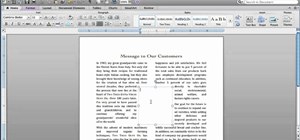
- #Microsoft word 2011 for mac tutorial how to#
- #Microsoft word 2011 for mac tutorial software#
- #Microsoft word 2011 for mac tutorial code#
You may be wondering, what the heck is kerning? Very simply, it’s the spacing between two specific letters. If you set this number to 12, kerning will not be applied to words that are point size 11 or smaller. This means kerning will be applied anytime you’re using a point size of 8 or above. Set the number in the box next door to the smallest number possible (usually 8). This is where the Opentype magic happens! The first thing you should do is set your character scale to 100%, and make sure that the ‘Kerning for fonts:’ button is checked. This is exactly how the letters will appear in your document. Notice that the preview window at the bottom of this dialogue box is ‘live’ – the name of the font will grow or shrink based on the letter size you select. We’ll leave the rest of the options set to default/blank. Choose the style you prefer (Ondise looks best as ‘regular’) and the letter size. In this example, we’ll select the font, Ondise. First, we’ll make sure our ‘Font’ settings are correct. This will pull up a dialogue box with two tabs, ‘Font’ and ‘Advanced’. On the main menu, click the ‘Format’ option and select ‘Font’ from the drop-down menu. The menus and options look similar in newer versions, but you can always refer to Microsoft Office’s support page for instructions specific to your software.) (In this tutorial, I am using Word 2011 for Mac. Once that’s done, simply open up the program and start a blank document. Microsoft started offering fancy Opentype feature support in Word 2010, so if you’re using an earlier copy, you’ll need to upgrade. So, how do we start switching these cool features on? The first step is to make sure you’re running up-to-date software.

#Microsoft word 2011 for mac tutorial code#
And that’s a shame, because almost every Opentype font has this cool code stuff built right in. So they hide these buttons deep inside advanced option menus, or worse still, pretend like fancy font code doesn’t exist. Talk about power, right? For whatever reason, though, some programs **cough cough, Microsoft Word** assume that you would rather not take over the world with swashed and flourished documents. The complicated swapping happens behind the scenes all you have to do is click a few buttons and your program will take care of the rest.

You see, font designers don’t just create letters – they actually program those letters to respond to your commands. Basically, this code takes a standard alphabet and makes it do amazing things for you!
#Microsoft word 2011 for mac tutorial software#
What are Opentype features and why should you care about them? Well, these are little bits of code (sometimes big bits!) that tell your software to do certain actions like inserting swashes, substituting alternate letters, and enabling connected letter pairs called ‘ligatures’.
#Microsoft word 2011 for mac tutorial how to#
Today, we’re talking shop, Microsoft Word style! Specifically, how to turn Opentype features on & off within the advanced menu options.


 0 kommentar(er)
0 kommentar(er)
